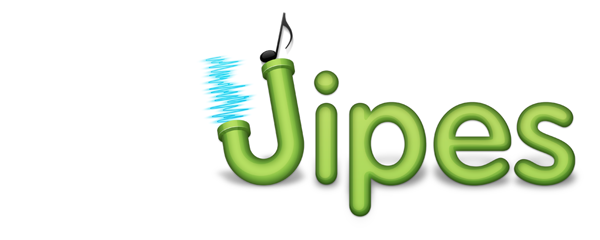Getting Started
The easiest way to use Jipes (other than simply using the jar) is to start a Maven project and introduce a Jipes dependency.
To do so, add something like this to the dependencies section of your pom:
<dependency>
<groupId>com.tagtraum</groupId>
<artifactId>jipes</artifactId>
<version>0.9.17</version>
</dependency>
Once you successfully added the dependency, you can create an IDE project for your favorite IDE by simply opening the pom.xml file.
Since the Jipes source code is in the repository and was downloaded during project creation, you can now easily access the source code and the javadocs through your IDE.
Tip: For most audio formats like mp3 you will need another dependency that allows you to decode the compressed signal. SampledSP libraries come in very handy here.
First Steps
Jipes lets you process a signal by a directed graph of processors that each manipulate the signal and provide input for the next processor in the graph.
To set up and run this processing graph, we first have to define a SignalSource. The easiest way to do this, is to instantiate an AudioSignalSource. It uses the Java AudioSystem to obtain an AudioInputStream from the given file.
SignalSource<AudioBuffer> source = new AudioSignalSource(new File("mono.wav"));
SignalPump<AudioBuffer> pump = new SignalPump<AudioBuffer>(source);
The snippet above shows how to connect a SignalPump with a SignalSource. Note that both are parametrized with the type AudioBuffer, because we typically want to process data of that type. It also happens to be the type delivered by AudioSignalSource.
Now that we have a pump that has a source, we need to specify where to pump those AudioBuffers to. As our first example, we will compute the zero crossing rate, an indicator for signal noisiness. The higher the value, the noisier the signal. Obviously the zero crossing rate is of type Float. That means we have to define a SignalProcessor that takes AudioBuffers as input and calculates Floats as output.
Since we don’t want to start from scratch, we simply inherit from AbstractSignalProcessor. It provides a skeleton implementation for both SignalProcessors and SignalPullProcessors - we will ignore the latter for now. Important for us is only that this abstract superclass already implements a bunch of infrastructure methods, so that we don’t have to take care of them anymore.
The only method we have to implement is the processNext method. In it we put the logic for computing the zero crossing rate.
String id = "ZCR";
SignalProcessor<AudioBuffer, Float> zeroCrossingRateProcessor = new AbstractSignalProcessor<AudioBuffer, Float>(id) {
private int samples;
private int crossings;
private float lastSample;
/**
* Computes the zero crossing rate for the given and all preceding audio buffers.
*
* @param buffer audio buffer
* @return current zero crossing rate
*/
protected Float processNext(AudioBuffer buffer) throws IOException {
// we assume a single-channel/mono source
samples += buffer.getNumberOfSamples();
for (final float sample : buffer.getData()) {
crossings += lastSample * sample >= 0 ? 0 : 1;
lastSample = sample;
}
return crossings / (float) samples;
}
};
Now that we have defined a simple processor, we just need to add it to the pump and start pumping, i.e. fill an AudioBuffer with data from the source, have the data processed by our zeroCrossingRate-processor, fill the buffer again and again let it be processed and so forth. In Jipes this is done by the ‘pump()’ method:
pump.add(zeroCrossingRateProcessor); Map<Object, Object> results = pump.pump(); Float zeroCrossingRate = (Float)results.get(id);
The pump() method also returns a map of the results of all added processors with their ids as keys. In our simple example we can easily look up the last zero crossing rate under the id "ZCR".
Et voilà!
We just built our first feature processor.
Building a Graph
Now, you probably noticed that little Java comment “we assume a single-channel/mono source” and thought “wow, that’s quite limiting…” Well, be assured, Jipes does not limit you to mono files. But realistically you probably have a lot of stereo data that you only want to deal with in mono.
Jipes has a solution for that.
In its com.tagtraum.jipes.audio package Jipes offers a number of useful standard audio processors (e.g. FFT, ConstantQTransform, SlidingWindow, Downsample, Novelty, SelfSimilarity, ..) that help you deal with the common conversion tasks you face all the time. One of them is certainly converting multi-channel input to single channel by averaging the channels. That’s exactly what the Mono processor does.
To first convert the data to mono and then compute the zero crossing rate we have to build a pipeline. Like this:
SignalPipeline<AudioBuffer, Float> pipeline = new SignalPipeline<AudioBuffer, Float>(
new Mono(),
zeroCrossingRateProcessor
);
SignalPump<AudioBuffer> stereoPump = new SignalPump<AudioBuffer>(new AudioSignalSource(new File("stereo.wav")));
stereoPump.add(pipeline);
Map<Object, Object> results = stereoPump.pump();
Float zeroCrossingRate = (Float)results.get(id);
As you probably have guessed, the SignalPipeline allows you to chain multiple processors. One processor’s output becomes the next one’s input. They are connected automatically. A side-effect of this comfortable solution is, that type-checking is circumvented. Now, if you know what you’re doing, that’s not a problem, but if you want to make sure everything fits, you can also connect them yourself, without using the pipeline class. It’s done with the connectTo(...) method:
final SignalProcessor<AudioBuffer, AudioBuffer> head = new Mono();
head
.connectTo(coolProcessorNumber1)
.connectTo(coolProcessorNumber2)
.connectTo(coolProcessorNumber3)
.connectTo(coolProcessorNumber4)
;
coolPump.add(head);
...
Since the connectTo(...) method conveniently returns the just connected processor (i.e. its parameter), you can easily chain calls to build your own pipeline.
Using Functions
In our zero crossing rate example we decided to subclass an abstract skeleton processor. While that is certainly a valid approach to create processing functionality, there is a more elegant one:
Function objects.
In its com.tagtraum.jipes.math sub-package Jipes defines a couple of interfaces that allow you to define mapping-, aggregation- and distance-functions. When thinking of the zero crossing rate in terms of a function, we need to define an AggregateFunction:
// first create a common function for float arrays
AggregateFunction<float[], Float> zcrFloatFunction = new AggregateFunction<float[], Float>() {
private int samples;
private int crossings;
private float lastSample;
public Float aggregate(float[] data) {
samples += data.length;
for (final float sample : data) {
crossings += lastSample * sample >= 0 ? 0 : 1;
lastSample = sample;
}
return crossings / (float) samples;
}
}
// create an AudioBuffer version of the float[] function
AggregateFunction<AudioBuffer, Float> zcrFunction = AudioBufferFunctions.createAggregateFunction(zcrFloatFunction);
// register the function with an Aggregate processor
SignalProcessor<AudioBuffer, Float> zcrProcessor = new Aggregate<AudioBuffer, Float>(zcrFunction);
We could of course define the function right away for the types AudioBuffer and Float. However, for illustrative purposes we take a little detour and define it for a simple float[]. That way we define a domain independent version, one that we could perhaps re-use somewhere else. To actually use it for AudioBuffers, we wrap it using the AudioBufferFunctions.createAggregateFunction(...) method. Once that is done, we create an Aggregate processor that uses the function.
At first glance, this might look like a couple of unnecessary indirections… until you realize that this way of putting things together lets you create complex feature pipelines quickly.
Just code up the mathematical function you need and re-use it at your convenience. And of course, Jipes comes with a bunch of functions already built in. They can be found in the AggregateFunctions, MapFunctions and DistanceFunctions classes.
Good examples for MapFunctions are btw filters or windows (Hann, Hamming & Co).
Putting it all together
Now that we know how to build functions, processors and pipelines, let’s put it all together and build something a little more complex. Perhaps something that needs a LogFrequencySpectrum with certain properties. A superMagicPipeline:
SignalPipeline<AudioBuffer, Float> superMagicPipeline = new SignalPipeline<AudioBuffer, Float>(
// convert to mono
new Mono(),
// quarter frequency FIR low pass filter
new Mapping<AudioBuffer>(AudioBufferFunctions.createMapFunction(Filters.createFir1_16thOrderLowpassCutoffQuarter())),
// downsample: keep only every 4th frame
new Downsample(4),
// window with size 4k and hopsize 2k
new SlidingWindow(4 * 1024, 2 * 1024),
// only look at the first 40k frames
new FrameNumberFilter(0, 40 * 1024),
// apply Hamming window of size 4k
new Mapping<AudioBuffer>(AudioBufferFunctions.createMapFunction(new WindowFunctions.Hamming(4 * 1024))),
// perform constant Q transform with given min/max frequencies and 36 bins per octave
new ConstantQTransform(25.956543f, 3520.0f, 12*3),
// and now do something super magically fancy with the provided log frequency spectra :-)
new SuperMagicProcessor()
);
And now imagine you have a second pipeline, that needs the same log frequency spectra. Let’s call it unbelievablyCoolPipeline:
SignalPipeline<AudioBuffer, Float> unbelievablyCoolPipeline = new SignalPipeline<AudioBuffer, Float>(
new Mono(),
new Mapping<AudioBuffer>(AudioBufferFunctions.createMapFunction(Filters.createFir1_16thOrderLowpassCutoffQuarter())),
new Downsample(4),
new SlidingWindow(4 * 1024, 2 * 1024),
new FrameNumberFilter(0, 40 * 1024),
new Mapping<AudioBuffer>(AudioBufferFunctions.createMapFunction(new WindowFunctions.Hamming(4 * 1024))),
new ConstantQTransform(25.956543f, 3520.0f, 12*3),
// do something unbelievably fancy with the provided log frequency spectra
new UnbelievablyCoolProcessor()
);
Since we are interested in results from both pipelines we simply add them both to a pump and call its pump() method. The nifty thing: Internally Jipes rebuilds the pipelines, so that the first part of both pipelines is only executed once (this implies that you shouldn’t do anything with a pipeline, once you added it)!
... pump.add(superMagicPipeline); pump.add(unbelievablyCoolPipeline); Map<Object, Object> results = pump.pump(); ...
Note that this optimization relies on the processors occurring in the same order and being equal in the sense of their equals(...) method. So when implementing your own processors, make sure you go all the way..


